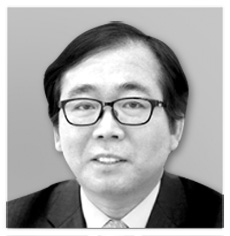Trading nukes for aid

*The author is the chief editor of the JoongAng Ilbo.
The best scenario for resolving the North Korean nuclear crisis is exchanging a “complete, verifiable and irreversible guarantee of regime survival” with complete, verifiable and irreversible denuclearization. But the North is rejecting the Libyan model, in which it gives up nuclear weapons first and receives compensation later. The North is criticizing the South and the United States. It canceled high-level talks with South Korea and has refused to allow South Korean reporters to attend the planned shutdown of the nuclear test site in Punggye-ri.
The North is expressing its frustration toward the uncertainty of regime security ahead of the summit of the century between its leader Kim Jong-un and U.S. President Donald Trump. Trump is now presenting a “Trump model” to calm the North while issuing a warning that the North will face a devastating outcome if negotiations fail. Trump is also hinting that China is behind the North’s shift in attitude, triggering a conflict between Washington and Beijing. All aspects of insecurity are emerging at once.
If the North decides to hide its highly enriched uranium, inspectors from the International Atomic Energy Agency have no way to find it. Therefore, a more fundamental resolution is needed. As soon as denuclearization is complete, the North should be included in the global economic system and given massive public development assistance to remove any reason for its use of nuclear arms.
There is an untold story between the two Koreas that took place 26 years ago. Dr. Yoo Jang-hee, then head of the Korea Institute for International Economic Policy, made a secret visit to Pyongyang in May 1992. He was accompanied by 12 experts in infrastructure and industrial development. Officials from the United Nations Development Program (UNDP) joined them in Japan, and they all arrived at Pyongyang International Airport aboard an Air Koryo plane.
The visit was the product of an agreement between then-South Korean President Roh Tae-woo and then-North Korean leader Kim Il Sung. Kim told Roh that he wanted to develop Rajin and Sonbong and asked his South Korean counterpart to create a good development plan. Kim also told Roh that money was not an issue.
Kim wanted the UNDP to secure funding from the World Bank and Asia Development Bank. The North was in desperate need of the South’s help and experience. Roh, who successfully cooperated with Kim to facilitate the two Koreas’ joint entry to the UN in 1991 and created the inter-Korean Basic Agreement, gladly agreed to help.
South Korean experts surveyed Rajin and Sonbong, created a draft plan and delivered it to the North. Kim Dal-hyon, North Korea’s deputy prime minister, and Ri Song-dae, chairman of the State External Economic Affairs Commission, were the counterparts to the South Korean experts.
Two months later, Kim Dal-hyon visited the South and toured the factories of Samsung Electronics and Daewoo Motors. North Korean leader Kim Il Sung had referred to him as a genius and trusted him to lead a plan to reform and open up the North based on China’s model. “The South has developed so much, but we wasted so much time,” he said. “We don’t have money because we are spending too much on the military.”
In 1993, South Korean President Kim Young-sam invited Dr. Yoo to the Blue House and ordered him to create a plan to expand the Basic Agreement between the two Koreas. “Kim Il Sung is a magnate, so we will lose unless we have perfect preparation,” Kim Young-sam told Yoo at the time.
The two Koreas then scheduled an inter-Korean summit on July 25, 1994. The plan, however, fell through after Kim Il Sung suddenly died on July 8.
In his New Year’s address in 2015, North Korean leader Kim Jong-un mentioned his late grandfather’s last handwritten memo, left shortly before his death ahead of the planned inter-Korean summit. A senior South Korean official said this was Kim Jong-un showing his genuine intent to accomplish what his father and grandfather were unable to do. This determination must have been based on the self-awareness that economic development is impossible as long as the North keeps its nuclear weapons.
According to the secret project between the two Koreas in 1992, the South was to create a development blueprint for the North, while the UNDP would endorse it and international organizations would fund it. That arrangement is still valid. Kim Dong-yeon, South Korea’s finance minister, recently said that the World Bank, Asia Development Bank and European Bank for Reconstruction and Development are willing to participate in development if the North reforms and opens up its country. “For the North to receive assistance, it must join the International Monetary Fund first,” he said.
Unless the South helps the North, it has no ability to come up with the funds, estimated at about 124.1 trillion won ($114.4 billion) over the next 30 years, to develop infrastructure such as railways, roads and electricity. Kim Jong-un must see the big picture and trust South Korea and the United States. He must accept complete, verifiable and irreversible denuclearization. A peace treaty and diplomatic relations with the United States will not guarantee the complete regime security that the North wants. That is why the North must join the global economic system.
As we have seen in the case of 1992, the South’s role is irreplaceable. It must be the core of the Moon Jae-in administration’s new economic vision. International development organizations are controlled by the United States. Moon must persuade Trump during their summit meeting in Washington on a blueprint to rebuild the North’s economy, with participation from the world, after the country’s complete denuclearization.
JoongAng Ilbo, May 21, Page 27










with the Korea JoongAng Daily
To write comments, please log in to one of the accounts.
Standards Board Policy (0/250자)